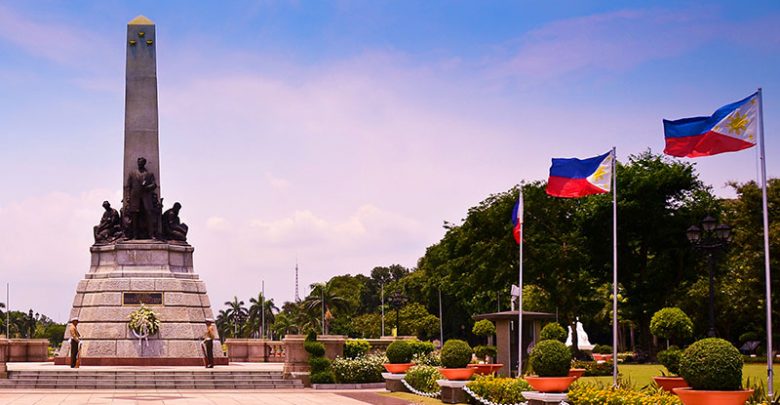Rizal Park

To the North of these districts, just South of Intramuros, is Rizal Park, named after the national hero of the Philippines, who was executed here by the Spaniards on 30 December 1896. It is also known as Luneta, the little moon, after a demilune outwork defending the Puerta Real which until 1910 occupied the position of the present Japanese garden. It was formerly called Bagumbayan, the new town, since the natives whom the Spaniards did not allow to live in the fortified town built their houses here. Rizal Park occupies an area of 60 hectares bounded on the West by Roxas Boulevard, on the North by Padre Burgos Street, on the East by Taft Avenue and on the South by T.M. Kalaw Street, Although it offers little shade during the heat of the day, it is a popular resort of the people of Manila, particularly in the evening. The entrance is in Roxas Boulevard. The flag of the Philippines flies on a flagstaff from which the American flag was hauled down on 4 July 1946, the day on which the Philippines became independent. All distances on the island of Luzon are measured from here. Beyond the flag is the majestic monument of Jose Rizal (by the Italian Carlo Nicoli and the Swiss Richard Kissling), erected in 1913, when his remains were transferred here. There is a permanent guard of honour, changed every six hours. On either side are bronze tablets with quotations (in Spanish and Tagalog) from Rizal’s famous poem “Last Farewell”. On the left north side is the spot, marked by a marble and bronze plaque, on which Rizal was executed on 30 December 1896, just after 7 in the morning. Beyond the monument, to the left is an obelisk, marking the spot where the three priests Jose Burgos, Mariano Gomez and Jacinto Zamora, were garroted on 17 February 1872. On the right is an allegorical monument (by Martinez, restored by A. Caedo) representing Madre Filipina which was brought here from Jones Bridge after 1945. Farther East is an artificial lake with fountains and a floral clock. On the North side is the Japanese garden, opened in 1967, a present from the Chinese of Taiwan to mark the centenary of Sun Yat Sen’s birth (1867); and beyond this are the Planetarium and the Japanese garden, a present from the Japanese people (1969). On the South side, beyond a cafeteria run by deaf mutes (communication by sign language), is the National Library, facing on to T.M. Kalaw Street (named after a former director of the Library). The 8-storey building, opened in 1966, contains a million volumes and fine collections of old maps and 19th century newspapers; it has 1600 places for readers.